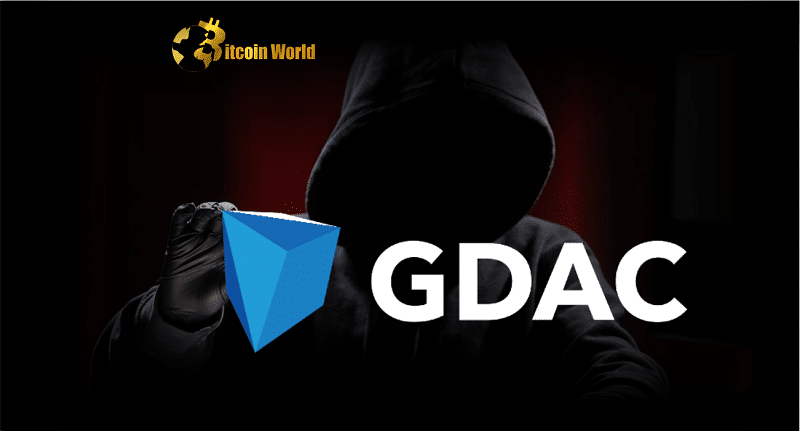In a startling turn of events for the cryptocurrency world, South Korean exchange GDAC has become the latest victim of a significant cyberattack. Hackers successfully pilfered approximately $13 million in digital assets, sending ripples of concern throughout the crypto community. This incident marks another setback for the digital asset sector, raising questions about security and the measures exchanges are taking to protect user funds.
What Exactly Happened at GDAC?
On April 9th, GDAC’s management delivered unwelcome news to its users: their platform had been breached. Cybercriminals managed to infiltrate the Gdac Hot Wallet, executing unauthorized transfers of a substantial amount of cryptocurrency to an external, unidentified wallet. Let’s break down the specifics of this alarming heist:
- Date of Incident: April 9th
- Target: Gdac Hot Wallet
- Assets Stolen:
| Cryptocurrency | Amount Stolen |
|---|---|
| Bitcoin (BTC) | 60+ |
| Ethereum (ETH) | 350.5+ |
| WEMIX | 10,000,000 |
| USDT | 220,000 |
These stolen tokens collectively amount to roughly $13 million, representing about 23% of GDAC’s total custodial assets. Imagine the shockwaves felt by users and the broader crypto market upon learning this news!
Immediate Response: Emergency Measures and Investigations
GDAC acted swiftly in response to the security breach, implementing a series of emergency measures to contain the damage and prevent further losses. Here’s a look at their immediate actions:
- Wallet Network Shutdown: GDAC immediately suspended its entire wallet network, encompassing deposit and withdrawal systems and all related servers. This crucial step aimed to freeze operations and prevent further unauthorized transactions.
- Law Enforcement Notification: Recognizing the severity of the situation, GDAC promptly notified law enforcement agencies, initiating a formal investigation into the hack.
- Regulatory and Industry Outreach: GDAC extended its communication beyond law enforcement, informing key regulatory bodies including the Financial Intelligence Unit (FIU) and the Korea Internet & Security Agency (KISA). They also reached out to DeFi (Decentralized Finance) managers and other cryptocurrency exchanges, seeking collaborative efforts to address the unfolding situation.
In a public notice, GDAC urged other virtual asset exchanges to proactively block deposits originating from the wallet address implicated in the withdrawals. This call for industry-wide cooperation underscores the interconnectedness of the crypto ecosystem and the need for collective action in the face of security threats.
What’s Next for GDAC and Affected Users?
Currently, GDAC is actively working with various entities to pinpoint the perpetrators behind the attack and strategize the resumption of full platform operations. However, the exchange has acknowledged the uncertainty surrounding the timeline for restoring deposit and withdrawal services.
“We ask for your understanding that, while the investigation is ongoing, it is difficult to confirm the resumption point of deposit and withdrawal,” GDAC stated, indicating that users will need to remain patient as the investigation progresses and recovery efforts unfold.
Echoes of Euler Finance: Are Crypto Hacks Becoming More Frequent?
This GDAC incident arrives on the heels of other high-profile crypto thefts, prompting concerns about the increasing sophistication and frequency of attacks. Remember the massive Euler Finance hack?
Just recently, DeFi lending platform Euler Finance experienced a staggering loss of approximately $200 million in digital assets due to a sophisticated flash loan attack. In a surprising twist in that case, the hacker, known as “Jacob,” initially demanded a $20 million ransom but eventually had a change of heart.
In a remarkable turn of events, “Jacob” returned over $100 million in ETH and even issued an apology. Further discussions and goodwill led to the complete return of all recoverable assets to Euler Finance, showcasing an unusual instance of ethical hacking and redemption within the often-unforgiving crypto space.
Key Takeaways and the Road Ahead
The GDAC hack, alongside the Euler Finance incident and others, serves as a stark reminder of the inherent risks within the cryptocurrency world. While the industry continues to mature and innovate, security remains a paramount concern.
Key points to consider:
- Security is paramount: Exchanges and users alike must prioritize robust security measures to safeguard digital assets. This includes multi-factor authentication, cold storage solutions, and continuous security audits.
- Industry Collaboration: The crypto community needs to foster greater collaboration and information sharing to combat cyber threats effectively. GDAC’s call for other exchanges to block suspicious addresses is a step in the right direction.
- Regulatory Scrutiny: These incidents may lead to increased regulatory pressure on cryptocurrency exchanges to implement stricter security protocols and consumer protection measures.
- User Awareness: Crypto users should exercise caution and due diligence when choosing exchanges and storing their digital assets. Understanding the risks associated with hot wallets and exploring cold storage options is crucial.
The investigation into the GDAC hack is ongoing, and the crypto community awaits updates on the recovery of funds and the identification of the perpetrators. As the digital asset landscape evolves, strengthening security infrastructure and fostering a culture of vigilance are essential to building trust and ensuring the long-term sustainability of the cryptocurrency ecosystem.
Disclaimer: The information provided is not trading advice, Bitcoinworld.co.in holds no liability for any investments made based on the information provided on this page. We strongly recommend independent research and/or consultation with a qualified professional before making any investment decisions.


